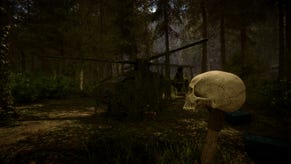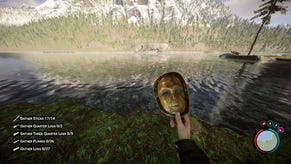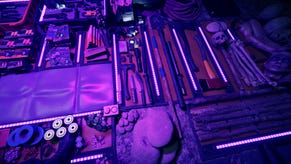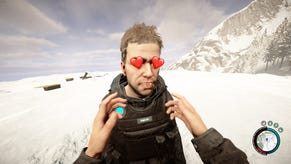The Forest: survival, horror and the guilt of killing - interview
John Robertson meets Endnight Games to discuss the horror game influenced by 70s movies, I Am Legend and… Disney?
"Our vision was always a game in which half of the time it's a place that you really want to be and then it's at night that the horror starts."
Disney. I must admit, I'm more than a little smitten with the house that Mickey built - the broadly-drawn characters, the sense of fairy tale and the stark, high-contrast visual approach combining to create a safe cocoon from which to escape the harsher realities of life. Disney, is not, however, something I tend to associate with survival horror video games.
Inspiration can come from the unlikeliest of sources, however, as my one-hour chat with Endnight Games, creators of upcoming 'survival horror simulator' The Forest, has further demonstrated. With a full weather and day/night cycles, the ability to carve out a section of the forest as a base for yourself and an enemy that is both aggressive and empathic, Endnight's goal is not to make your average horror game.
"Disney stuff was an inspiration for the daytime in the forest," explains creative director Ben Falcone. "There are God-rays from the sky everywhere, butterflies and generally cute looking areas. One of the things I don't like in horror games is when they're all one tone, when they're always just dark and depressing.
"Our vision was always a game in which half of the time it's a place that you really want to be and then it's at night that the horror starts. Our main goal is really just to do something completely different."
As a general rule, The Forest has not been influenced by video game horror as much as it has by other mediums. Set in a large open-world forest with a coastline and significantly large system of caves, inspiration for the sense of tone and place came more from movies and novels in the survival genre.
"Horror films from the 70s, and the Italian films from the 80s, and the book I Am Legend are all pretty big influences," Falcone continues. "We've all played horror games like Resident Evil and Silent Hill, but we've not really taken anything from those games."
Set up an environment that feels like something straight out of the original The Hills Have Eyes and let the player react to that as they see fit, that's the premise.
As the only survivor of a plane crash, your first moments spent in The Forest are concerned with taking in your surroundings and looting whatever you can from the wreckage. While there are limited food resources amongst the carnage, your main goal quickly becomes staying alive. That means figuring out how to stay safe and warm at night and how to gather food for sustenance.
Falcone teases that there is an "ending" to the game if players are being smart enough about picking up the visual clues and investigating them, but that he thinks of the game as "more about you being in a situation. You've been in a plane crash and you find yourself in this horror world with a threat from cannibals, the story is just what happens as you experience the game and that world."
While Endnight may not be taking cues from other horror games, the team has been influenced by the medium as a whole. That sense of unbounded exploration and the expectation that the player will seek to carve out a section of the world as their own is not all too dissimilar to the premises of Minecraft and Don't Starve, two games that Falcone is quick to highlight.
"Really, [The Forest] started with my frustration about most of the things I've been playing for the last few years," Falcone explains, "but Minecraft is something that's a really big inspiration. We also see our game as similar to Don't Starve, which is also kind of never ending.
"The excitement in Minecraft of being able to do whatever you want was something we wanted, but we wanted it in as photo-real an environment as we could by using cutting-edge PC technology to bring it to life and bring in some interesting AI threads.
"Obviously, we wanted to make something scary as well. We don't actually find a lot of horror games very scary and we're really aiming to make something truly terrifying."
Much of the fear-factor comes from those AI threads, in the form of cannibalistic, humanoid mutants that live and breathe in the game's world; hunting the same animals you hunt, foraging the same plants and seeing you as an unwelcome guest in their habitat. As nocturnal creatures, you're largely safe from their curiosity during daylight hours - giving you time to improve your stamina/health through exercise and build yourself a shelter using materials and tools you create yourself - but at night it's a different story.
Far from mindless killing machines, mutants do not wake up and decide to instantly go out on the hunt for you. In fact, they will not even know of your existence unless your paths cross and conflict ensues over territorial and/or resource disputes. Kill an animal that they're hunting and take it home for yourself and you can expect retaliation.
"We're trying to treat them like real inhabitants of the world as much as possible," lead animator Mike Mellor tells me. "Whenever we think about anything in the game we think about the reasons for its existence and its being there. So, the mutants have proper day/night routines and we give them lots of things to do around the forest.
"More than that, though, they feel sad when one of their comrades dies and they will try to drag an injured friend to safety and away from you if you're attacking them. You begin to understand that they do actually have their own feelings and aren't just zombie-like evil creatures. Even though they do want to eat you... [laughs]."
At the start of the game, when you're low on resources and still working out how best to survive, let alone take on mutants, getting involved in direct encounters is likely going to result in an early grave.
If you do happen to come across a group of them at this point, stealth is probably going to be your best option. Defensive traps can be crafted and deployed around your shelter, wet mud can be applied to your skin to help you blend into the foliage (a la Schwarzenegger in Predator) and leaves can be gathered to make a rough camouflage ghillie suit. Trees can also be cut down, not only good for providing the wood you'll need to build yourself a cabin, but also for making it harder for the mutants to sneak up on you while you're trying to see out the night.
;
Stealth needn't be entirely restricted to defence, it can also be used offensively. Falcone explains: "You can go to their caves and murder them in their sleep, which is an inspiration from I Am Legend.
That changes the world, because there are a limited amount of enemies and you can eventually wipe them all out. That's really difficult to do, but it ties in with our goal of creating a survival simulation and allowing people to play in lots of different ways."
While you can choose to enter their caves, Falcone is eager to let slip that many of the games more precious items are found only in such places and you'll need to brave the mutant's personal space in order to obtain them. The materials for a raft, for example, can be found deep in the caves, the construction of which allows you to sail out to locations that would be otherwise inaccessible.
"The deeper you go into the caves, the weirder and crazier the creatures get and there are some really cool character designs to support that, says Falcone. "There are moments when you're walking through a cave and your light might go out temporarily as you glimpse something coming towards you... that's really terrifying."
"Our vision was always a game in which half of the time it's a place that you really want to be and then it's at night that the horror starts."
If you do happen to find yourself face-to-face with the enemy, the promise is that they're going to be incredibly difficult to kill.
"They're very hard to kill and you have to be very violent to kill them," Falcone continues. "In lots of games you can shoot someone in the leg four times and they die instantly, or you hit them with a stick and they die. In our game, you hit them with a stick to make them fall over and then you get a rock and hit them over the head three or four times to kill them."
On the surface of it that may sound like mindless and gratuitous violence of the sort that video games are historically admonished for, but Falcone sees it differently:
"We really want to get across that it's very difficult to actually kill someone and we want each kill the player performs to be something they feel some guilt about. What we don't want is just mindless killing."
And that's perhaps the most striking thing about The Forest, nothing about the project seems mindless, derivative or done simply for the sake of embellishing upon a simple effect or gaming tradition.
Endnight is currently thinking about whether or not to include any form of co-op feature in the world, acknowledging that it could add to the sense of randomness and the organic nature of the game, but they're keen to stay away from the "mass multiplayer" feel of DayZ or Rust.
It's that very sense of not wanting to do what other games are already doing that makes The Forest such an intriguing proposition.
According to Endnight, an early-access edition of the game will be available at some point over "the next couple of months". Mark your diaries.












